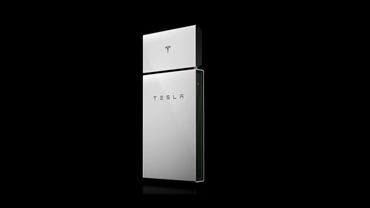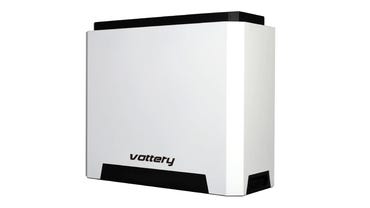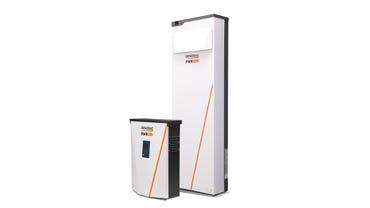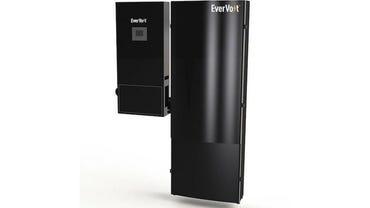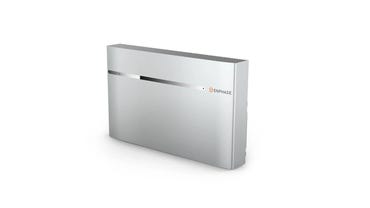The 5 best home battery and backup systems of 2022
If you have a power outage and it looks like the power will be off for an extended period of time, you need backup power from a battery system or battery backup unit.
You can either maintain power for a few hours with an air-cooled home generator that is powered by either gasoline or propane, or you could buy a much more expensive liquid-cooled generator that will keep your lights on for a while longer.
But if power outages are regular events where you live, you might want to consider installing a set of backup batteries to supply you with electricity when you are off the grid.
These battery storage systems can either consist of dry or wet batteries. Typical dry batteries are lithium-ion batteries used in mobile devices or lithium ferro phosphate batteries commonly used in solar battery backup systems. They do not tend to work well in very hot or cold environments, and some will not work at all if the temperature stays below freezing.
Wet cell batteries use a liquid electrolyte to generate electricity. Lead-acid batteries use lead plates that sit in an electrolyte of sulphuric acid –or acid batteries. Batteries can also contain gel. Gel batteries are a form of lead-acid battery in the class of VRLA (value-regulated lead acid). The acid electrolyte is mixed with a type of silica to produce a gel that will not leak if the battery falls over.
Other batteries have absorbed glass matting (AGM) in place to hold the electrolyte in contact with the plates of the battery. However, AGM batteries can lose power in very cold conditions.
For a seemingly never-ending supply of power, consider a solar panel system to connect to your energy storage system. Your battery backup system will be charged using solar power so that you have a regular supply of solar energy from your solar batteries.
Solar batteries, also known as solar PV (photovoltaic) systems, will charge your home battery system with renewable energy. If you cannot afford a full set of solar panels, a 13.4KWh Tesla Power wall, and a UPS that is also a surge protector and switches itself on during power outages, how can you run your important items if the power goes out?
If you only want to run a few low-power items, charge your mobile devices or plug in a light, then a portable battery with a solar charger might be more aligned with your budget. I have included some of these lower-cost items at the bottom of this list.
There are a few important considerations and calculations you need to make before you decide how big your backup system needs to be. You want your home battery storage system to be adequate for your needs. There is more on that at the bottom of this guide.
Tesla Powerwall +
Best home battery backup overall
Capacity: 13.5kWh | Power source: Solar panels | Controls: Dedicated app | Multi-unit configurations: Yes
The market leader in battery backup systems, the Tesla Powerwall, is equipped with all the bells and whistles to make your energy switch to backup battery power as simple as possible. Recharge with solar PV panels, and enjoy the stored solar energy for times when you are off-grid.
The Tesla Powerwall + will give you an energy capacity of 13.5kWh and has a power rating of 7.6kW delivering continuous power of 5.8kW in no sun. The Powerwall + has a ten-year guarantee and can be monitored and managed using its app. You can only buy a Powerwall if you also purchase Tesla's own solar panels.
You can connect up to 10 Powerwalls to ensure you have the right-sized backup batteries for your home. It is recommended to use the Tesla Powerwall with a solar panel system. Some states such as WA (22%) offer a Federal Solar Investment Tax Credit to help with costs.
Pros:
- 10 year warranty
- Stack up to 10 together
- Dedicated app for power management
- Great power distribution even in no sun
Cons:
- Very expensive
- Only available with purchase of Tesla-branded solar panels
Vottery Powerwall
Most affordable
Capacity: Up to 120Ah | Power source: Solar panels | Controls: Dedicated PC program | Multi-unit configurations: Yes
The Vottery home energy storage system has storage options up to 6KWh with 120Ah battery capacity and a 5kW inverter. Charge it from your solar panels, and if you need more than 6KWh, you can connect up to 10 of these systems in parallel to deliver up to 60KWh.
Pro:
- More affordable than some other options
- Multiple capacity and output options
- Connect up to 10 units
Cons:
- Control program has steep learning curve
- No warranty
Generac PWRcell
Best for third-party solar panels
Capacity: Up to 36kWh | Power source: Solar panels | Controls: Dedicated app and control unit | Multi-unit configurations: Yes
The standard Generac PWRcell system provides 9kWh of storage capacity from three Lithium Ion battery modules rated at 3.0 kWh. The system includes an inverter and a battery storage cabinet.
Usefully the PWRcell will work with solar panels from most manufacturers so there is no vendor lock in. Its modular design means that you can expand your storage capacity expanding in increments of 3kWh up to 36kWh. It has a ten-year limited guarantee, and can be managed and monitored with an app.
Pros:
- Modular design to suit different home sizes
- Intuitive app and control unit
- 10 year warranty
- Works with most solar panels
Cons:
- Very, very expensive
- Price doesn't include solar panels/installation
Panasonic EverVolt DC Coupled Battery System
Best modular design
Capacity: Up to 102kWh | Power source: Solar panels | Controls: Dedicated app | Multi-unit configurations: Yes
The Panasonic EverVolt EVDC-105-4 Standard model is a DC-coupled 11.4 kWh battery storage system. It has a modular design with an integrated 5.5 kW DC 120/240Vac inverter and PowerHub programmable controller. It will deliver 4.8 kW of continuous battery output power at 25A current and has 6 hours average backup capability. It has an app to monitor and control it and comes with a ten-year warranty.
Pros:
- 10 year warranty
- Modular design for power scaling
- Stack up to 3 units
- Can sell unused power to certain utility providers
Cons:
- Not as adaptable as other systems
- Not all utility companies allow you to sell unused energy
Enphase IQ Battery 10T
Best for smaller homes
Capacity: 10.08kWh | Power source: Solar panels | Controls: Dedicated app | Multi-unit configurations: No
The Enphase IQ Battery 10T will give you an energy capacity of 10.5kWh and will deliver 5.76KVA at peak output. It is comprised of three base Encharge 3T storage units. The batteries are made from Lithium Ferrous Phosphate (LFP) and this unit has a power rating of 3.84KW.
It cools passively so there are no moving parts or fans. It has a ten-year limited warranty and a mobile app to monitor and control the system. Professional installation is a must for this battery storage system.
Pros:
- Perfect for most homes
- Automatic remote updates
- Great warranty
Cons:
- No expandable design
- Extended warranty costs extra
What is the best home battery backup system?
In our opinion, the Tesla Powerwall+ is the top choice for a whole-home battery backup system. It has a capacity of 13.5kWh, a 10 year warranty, and intuitive companion app for monitoring energy distribution and use. You can even create a network of up to 10 Powerwall+ units to adapt to your changing energy needs.
|
Home battery and backup system |
Price |
Capacity |
Expandable design? |
|
Tesla Powerwall+ |
$12,000 |
13.5kWh |
Yes |
|
Vottery Powerwall |
$4999 |
Up to 120Ah |
Yes |
|
Generac PWERcell |
$20,000 |
9kWh |
Yes |
|
Panasonic EverVolt |
$15,880 |
11.4kWh |
Yes |
|
Enphase IQ Battery 10T |
$10,000 |
10.5kWh |
No |
Which battery backup system is right for you?
You'll need to determine the wattage and voltage consumption of your entire household. Thankfully, Lowe's has a handy worksheet to help you figure out your power needs. Once you know know how many watts and volts your appliances use, you'll want to add at least 20 percent to the total; that way, if you add electronics or appliances, or something starts to draw more power than usual, your system will be able to keep up.
And if retail and installation pricing seems a bit steep, many places offer some sort of payment plan so you can break the final cost into more affordable, monthly payments.
|
Choose this… |
If you need this… |
|
Tesla Powerwall+ |
A high output network for larger homes |
|
Vottery Powerwall |
A medium-sized power network |
|
Generac PWRcell |
A backup system that works with any solar panel brand |
|
Panasonic EverVolt |
A system with a modular design to adapt to your needs |
|
Enphase IQ Battery 10T |
A smaller power network for a single building |
How did we choose these home battery backup systems?
Aside from retail pricing and installation costs, we carefully considered peak, start, and running voltage and amperage. Since these are permanent installations, you need to make sure the system is capable of handling the electrical load of all of your appliances on a daily basis. If you choose a system with less capacity than you need, you run the risk of frying the wiring in your whole house; but if you choose something with more capacity, not only will everything run smoothly, you have room to expand as your power needs change.
What type of home battery back-up system do you need?
Backup battery systems are generally charged by utility grid electricity or solar power. If you live in an area when you get great levels of sunshine, then consider using solar power to charge your batteries up during the day. Alternately, if your power outages are infrequent, then consider topping up the batteries using electricity when the cost is low.
How much power do you need?
You need to check the capacity of the batteries. This is usually measured in kilowatt hours (KWh). Any output, such as an inverter, will be measured in watts or kilowatts. Typically, the battery capacity should be more than the power generated by your system and ideally should store enough power to cope with 24 hours' worth of energy supply.
You also need to measure the surge current requirements of the items you need to power — especially if you need to start something like a sump pump motor. Don't expect to be able to power something like a pool filter or air conditioning for days on end.
Cost is also a major issue — especially if your requirements total over 15KWh of inverter power or over 30KWh per day for your batteries. You will also need to take into account inefficiencies, voltage drops, and other losses, and calculate to cover all eventualities.
How much load do you need from your battery backup system?
You will need to carefully consider peak load in KWh per day when calculating the size of battery power you need. If your energy requirements are low — such as lighting — then most backup systems will be able to cope with this. However, if you need to run items like sump pumps, air conditioning, or heavy start load items, then you will need to consider peak loads, too.
Are there alternative home battery backup systems to consider?
Sometimes, you don't need a continuous supply of backup power. That's where smaller, more emergency oriented units come in to provide backup power only when you need it. Here is a short list of emergency power stations I thought were great choices:

